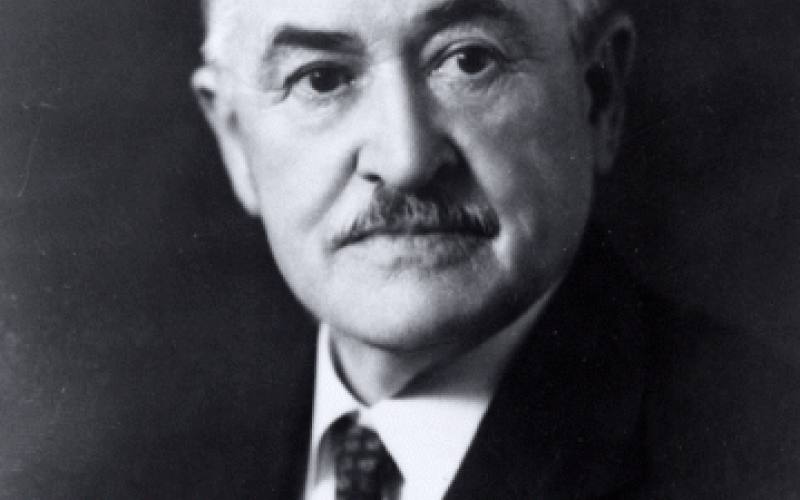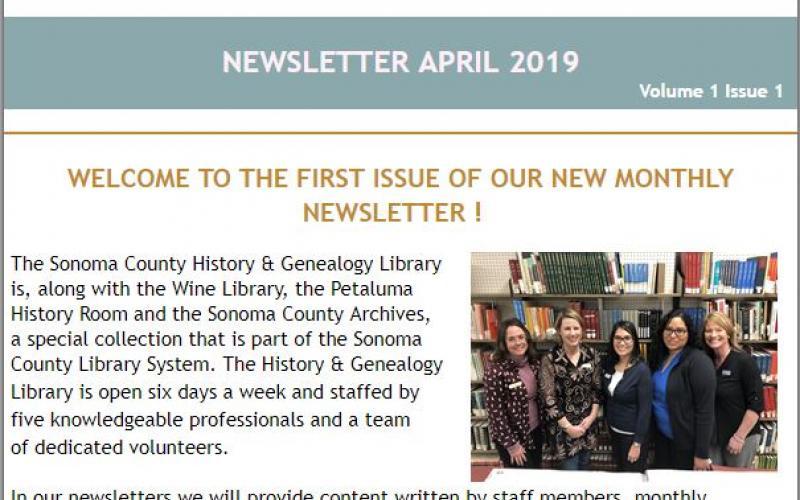Local History and Genealogy Notes
A Sonoma County Suffragent
Posted on October 16, 2019
As a precursor to the broadcast of a panel discussion focused on the role of men in the women's suffrage movement which will occur on Thursday, October 17, 2019, at the National Archives, I am pleased to share the following biographical sketch of a Sonoma County "suffragent" named Emmett Seawell (1862-1939) written by Steven M. Lovejoy, president of the Sonoma County Genealogical Society and member of the Sonoma County Historical Records Commission.
Emmett Seawell was a Sonoma County Superior Court Judge, 1903-1922; California Supreme Court Associate Justice, 1923-1939; and a strong supporter of women’s suffrage, especially during the successful 1911 campaign to pass an amendment to the California State Constitution giving women the right to vote.
Born in Yountville, Napa County, California, on 5 April 1862, Emmett Seawell was one of eleven children of William N. and Sarah A. (Rickman) Seawell. He came to Sonoma County as a young boy and attended public school in Santa Rosa. After working a few years in the printing trade he entered Pacific Methodist College and graduated from there in May 1887. He worked for a time as a reporter at various newspapers and then, in 1888 entered the law office of J. W. Oates. After his admission to the bar on 6, May 1890 Seawell formed a partnership with W. F. Cowen and practiced his profession in Santa Rosa. On 20 March 1892, he married Ida S. Graeter in Santa Rosa, and to this union, two children were born, Dorothy, in 1904, and Emmett James, in 1907. Seawell was elected District Attorney of Sonoma County in 1892 and again in 1895, serving a total of six years in that position. He ran unsuccessfully for Congress in 1898 as a Democrat, but in 1902 he was elected as a Sonoma County Superior Court Judge, an office he held until 1922.
On 24 June 1911, Judge Seawell lent his courtroom for a meeting of the Santa Rosa Political Equality Club at which he and a number of other speakers discussed women’s suffrage. His address was described by the Press Democrat newspaper the next day as “eloquent and forceful,” tracing “the achievements of women in the history of the world,” and telling “of their bravery and distinguished service in the cause of humanity.” He “did not mince matters when he said he was in favor of suffrage for women.” On 22 August 1911 at a meeting of the Santa Rosa Political Equality Association at the Columbia Theater in Santa Rosa, attorney Frances McGaughey Martin, president of the Association, read a letter by Judge Seawell to the assembled crowd “eulogizing the movement in favor of the ballot for women.”
In 1922 Seawell was a candidate for associate justice of the California Supreme Court, and female voters were reminded of the Judge’s strong support of the women’s suffrage movement eleven years earlier. Frances McGaughey Martin wrote in an open letter, which was quoted in the Press Democrat: “The women workers in the memorable campaign of 1911 will recall how difficult it was to persuade men prominent in public life to declare themselves in sympathy with the cause we women were so earnestly battling for. One conspicuous figure who stood boldly with us throughout the entire fight and the 1911 campaign, which resulted in giving women the right of full citizenship was Judge Emmett Seawell. He spoke and worked publicly and effectively for women.” Philip M. Carey, an old family friend of the Seawells, spoke before the California League of Women Voters in Oakland in August 1922 and noted: “The women voters who were fighting for Women Suffrage in 1911 have never forgotten that he was their fearless and able champion then. In those days when the cause needed assistance, he gave early and valuable help.” Judge Seawell was elected to the California Supreme Court bench as an associate justice on 7 November 1922, no doubt with the support of many grateful women voters. He served in this position until 1939.
Judge Seawell died on 7 July 1939 of a heart attack while sitting with the California Supreme Court en banc in San Francisco. While the Court was hearing arguments, he quietly excused himself from the bench, walked to his chambers to lie down, and passed away.[4] He was buried on 10 July 1939 in Mountain View Cemetery in Oakland, California after final rites at the Oakland Scottish Rite Temple and graveside services by the Grand Parlor of the Native Sons of the Golden West. He was a thirty-second degree Mason and a member of the Elks, the Rotary, and the Commonwealth Clubs. He was also a past grand president of the Native Sons of the Golden West.
Sources:
Tom Gregory, History of Sonoma County, California, with Biographical Sketches of the Leading Men and Women of the County, who have been Identified with its Growth and Development from the Early Days to the Present Time (Los Angeles, California: Historic Record Company, 1911), 481–482.
“Judge Seawell Addresses Political Equality Club,” The Press Democrat (Santa Rosa, California), 25 June 1911, p. 9, cols. 1–2.
“A Splendid Address on Political Equality Here,” The Press Democrat (Santa Rosa, California), 23 August 1911, p. 10, cols. 1–2.
“Backing of Seawell as Suffrage Friend is Urged by S. R. Woman Attorney,” The Press Democrat (Santa Rosa, California), 16 July 1922, p. 3, cols. 3–4.
“Oakland Hears Glowing Tribute to Seawell as Friend Speaks For Him,” The Press Democrat (Santa Rosa, California), 9 August 1922, p. 6, cols. 2–3.
“Final Vote Count Shows Large Lead Given Richardson,” The Sacramento (California) Union, 16 December 1922, p. 1, col. 3 and p. 2., col. 4.
“State Justice Seawell Dies,” San Francisco (California) Examiner, 8 July 1939, p. 1, col. 2 and p. 6, cols. 1–3 and “Justice Emmet Seawell Dies Suddenly,” The Press Democrat (Santa Rosa, California), 8 July 1939, p. 1, cols. 7–8 and p. 3, cols. 1–3.
“Hundreds Join in Final Tribute to Justice Seawell,” Oakland (California) Tribune, 11 July 1939, Home Edition, p. 6, cols. 1–2 and Ancestry, Find A Grave, database with images (http://www.findagrave.com: accessed 4 August 2019), memorial 115882662, Judge Emmett Seawell (1862—1939), Mountain View Cemetery, Oakland, Alameda County, California; gravestone photograph by REHM.
Snapshot of Sonoma County Hop Harvest - 1926
Posted on August 11, 2019
Gaye LeBaron's article in today's Press Democrat, Taking a Look Back at Sonoma County's Long Agricultural, Immigrant History, provides the inspiration for this post.
According to the Healdsburg Enterprise, Milton Wasserman, owner of a 180 acre hop ranch northwest of Santa Rosa, estimated that six thousand bales of hops, totaling 10,000,000 pounds of green blossoms were to be harvested in Sonoma County during the fall of 1926. Pickers were paid $1.25 per 100 pounds and harvesting began in August. The owners of the Wohler Ranch in Healdsburg, hired 1,000 pickers. On September 10, 1926, the Sotoyome Scimitar reported that 97,000 pounds of hops had been dried in 24 hours at the Wohler Ranch.
Access to a digital version of the Healdsburg Tribune, the Sotoyome Scimitar, and many of other newspapers is available at no charge via the California Digital Newspaper Collection.
Additional information on the history of Sonoma County's hop industry can be found at the Sonoma County History & Genealogy Library, the Healdsburg Museum, and the Windsor Historical Society all of which will be participating in the Sonoma County Archives Crawl on Saturday, October 5, 2019. Stay tuned for more information on that exciting event!
Help Us Name the Sweethearts!
Posted on June 24, 2019
During the first four decades of its existence, Future Farmers of America (FFA) was strictly a boys club, helping to develop the next generation of agriculturists – male agriculturists. It wasn’t until 1969 that the National FFA declared that girls were to be permitted to all chapters, including those in Sonoma County. Today, women hold half of all leadership positions in FFA.
Prior to 1969, the only way girls could participate in FFA was as a “Sweetheart.” According to Pat Pedersen (1931-2010), Sonoma County Fair’s FFA Sweetheart contest was established in the late 1950s after Wesley Jamison (1907-1989), Sonoma County Fair board member at the time, had seen such a contest in Georgia and thought Sonoma County could benefit from a similar event.
Pat Pedersen was a judge for two years before she was asked to be the director of the contest in 1964, a job she held for a number of years.
Contestants of the Sweetheart contest were judged for appearance, poise, stage presentation, and other technicalities. Winners received a cash award and took part in a number of fair activities.
Can you help us identify the sweethearts in this Sonoma County Library photo? If so, please send an email to history@sonomalibrary.org
Local History & Genealogy Library Newsletter - April 2019
Posted on April 11, 2019
Read the first issue of our new monthly newsletter here - APRIL 2019
In our newsletters we will provide content written by staff members, monthly highlights at the library and information on new books, databases, and recently processed collections. We'll share library events as well as those hosted by our partner organizations. Up to date information on the Sonoma County Archives and links to interesting websites will be provided. We hope you enjoy this new way to keep you informed.
Subscribe by clicking this link - SIGN UP
Suffrage Will be the Theme by Katherine J. Rinehart
Posted on March 11, 2019
Leasa Graves, assistant director of the National Women's History Alliance, will present Ripe for Picking: The Impact of the Sonoma County Suffrage Movement. Ms. Graves will explore the topic of suffrage and role of Sarah Latimer Finley (1848-1937) as the Sonoma County Press Chairman of the Political Equality Association in detail.
Leasa and I are co-chairs of the Education and History Committee of WE 2020 – a countywide collaboration initiated by Supervisor Lynda Hopkins that has organized to commemorate the women’s suffrage centennial by honoring the past, celebrating the present, and advocating for the rights of all women of the future.
We hope Leasa's presentation will be the first of several events offered around Sonoma County as we and others prepare to celebrate the anniversary of the passage of the 19th Amendment which was approved by Congress on June 4, 1919, and ratified on August 18, 1920.
Do you or an organization you are affiliated with have plans to commemorate this milestone of democracy? The Centennial offers an unparalleled opportunity to research the history of the women's suffrage movement, examining closely those who were included and excluded and understanding the movement's relevance to issues of equal rights today? We'd love to hear from you. Please respond by using this simple survey.
Also, remember with advanced planning, the Sonoma County Library may be able to host your event, exhibit, etc. at one or more of our branches. For more information, please contact Katherine J. Rinehart at krinehart@sonomalibrary.org






